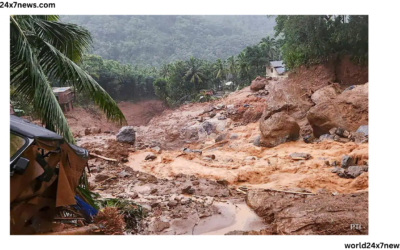The Devastating Wayanad Landslide: Causes, Impact, and Future Strategies

Introduction
Wayanad, a picturesque district in the northeastern part of Kerala, India, is known for its lush greenery, scenic landscapes, and rich biodiversity. However, in recent years, it has also become infamous for frequent landslides that have devastated communities and ecosystems. Understanding the causes, impacts, and preventive measures of these landslides is crucial for safeguarding this beautiful region.
Understanding Landslides
Definition of Landslides
A landslide is a geological phenomenon that involves the movement of rock, earth, or debris down a slope. This movement can be triggered by a variety of factors, leading to significant changes in the landscape and often causing damage to property and loss of life.
Causes of Landslides
Landslides can be caused by natural events as well as human activities. Let’s delve into these causes:
Natural Causes
- Heavy Rainfall: Intense and prolonged rainfall can saturate the soil, reducing its cohesion and triggering landslides.
- Earthquakes: Seismic activity can destabilize slopes, causing sudden landslides.
- Volcanic Eruptions: Volcanic activity can lead to landslides by rapidly altering the landscape.
Human-Induced Causes
- Deforestation: Removal of vegetation weakens the soil structure, making it more prone to landslides.
- Construction Activities: Unregulated construction can destabilize slopes and increase the risk of landslides.
- Mining: Mining activities can alter the natural stability of slopes, leading to landslides.
Geographical Context of Wayanad
Location and Topography
Wayanad is situated on the southern tip of the Deccan Plateau and is part of the Western Ghats, a mountain range known for its rich biodiversity. The district’s topography includes steep slopes, rolling hills, and deep valleys, making it susceptible to landslides.
Climate and Weather Patterns
Wayanad experiences a tropical climate with heavy monsoon rains from June to September. These rains are a primary factor in triggering landslides in the region.
History of Landslides in Wayanad
Notable Past Incidents
Wayanad has a history of landslides, with several significant incidents recorded over the past decades. These events have caused widespread destruction and loss of life.
Frequency and Impact
Landslides in Wayanad are becoming more frequent due to changes in climate patterns and increased human activities. The impact of these landslides has been severe, affecting thousands of lives and causing extensive property damage.
The 2019 Wayanad Landslide
Detailed Account of the Event
In August 2019, Wayanad experienced one of the most devastating landslides in its history. Triggered by incessant rainfall, the landslide buried several villages under mud and debris.
Areas Affected
The worst-affected areas included Puthumala and Meppadi, where entire hillsides collapsed, leading to a massive loss of life and property.
Immediate Impact
The immediate impact of the landslide was catastrophic, with over 50 people losing their lives and hundreds being displaced. The disaster also caused significant damage to infrastructure, including roads and bridges.
Causes of the 2019 Landslide
Heavy Rainfall
The primary cause of the 2019 landslide was the unusually heavy monsoon rainfall that saturated the soil, leading to its collapse.
Deforestation
Years of deforestation in the region had weakened the soil structure, making it more vulnerable to landslides.
Soil Erosion
Continuous soil erosion due to poor land management practices also contributed to the landslide.
Impact on Local Communities
Loss of Life and Property
The landslide resulted in a tragic loss of life and significant property damage. Homes were destroyed, and many families lost everything they owned.
Displacement of Residents
Hundreds of residents were displaced and had to seek shelter in temporary relief camps. The displacement caused emotional and psychological trauma to the affected individuals.
Economic Repercussions
The landslide also had severe economic repercussions, disrupting agriculture, the primary livelihood of the local population, and affecting the overall economy of the region.
Environmental Impact
Damage to Flora and Fauna
The landslide caused extensive damage to the local flora and fauna. Forested areas were destroyed, and wildlife habitats were severely affected.
Long-Term Ecological Changes
The ecological balance of the region has been disturbed, with long-term consequences for the environment. Soil quality has degraded, and the risk of further landslides has increased.
Government Response and Relief Efforts
Immediate Relief Measures
The government responded promptly to the disaster, launching rescue operations and providing immediate relief to the affected communities. Temporary shelters, food, and medical aid were provided to the displaced residents.
Long-Term Rehabilitation Plans
Long-term rehabilitation plans were also initiated, including the construction of new homes and the restoration of infrastructure. Efforts were made to rebuild the affected areas and help the community recover.
Community Resilience and Recovery
Local Community Efforts
The local community played a crucial role in the recovery process. Volunteers and local organizations worked tirelessly to provide aid and support to the affected families.
Role of NGOs and Other Organizations
Non-governmental organizations (NGOs) and other organizations also contributed significantly to the relief and rehabilitation efforts. They provided resources, expertise, and manpower to help rebuild the community.
Preventive Measures and Mitigation Strategies
Afforestation and Soil Conservation
One of the key preventive measures is afforestation and soil conservation. Planting trees and preserving vegetation can help stabilize the soil and reduce the risk of landslides.
Improved Infrastructure
Improving infrastructure, such as building retaining walls and proper drainage systems, can mitigate the impact of landslides and protect vulnerable areas.
Early Warning Systems
Implementing early warning systems can help predict landslides and provide timely alerts to the communities, allowing them to take preventive measures.
Role of Technology in Landslide Management
Satellite Monitoring
Satellite monitoring can provide real-time data on soil moisture and other factors that contribute to landslides. This information can be used to predict and prevent landslides.
Drones and Ground Sensors
Drones and ground sensors can be used to monitor vulnerable areas and detect early signs of landslides. This technology can help in taking timely preventive measures.
Challenges in Landslide Management
Funding and Resources
One of the major challenges in landslide management is the lack of funding and resources. Adequate investment is required to implement effective preventive measures and rehabilitation plans.
Coordination Among Agencies
Coordination among various agencies involved in disaster management is crucial for effective response and recovery. Ensuring seamless coordination can enhance the efficiency of relief efforts.
Future Outlook for Wayanad
Predicted Climate Changes
Climate change is expected to increase the frequency and intensity of rainfall in Wayanad, leading to a higher risk of landslides. It is essential to prepare for these changes and implement sustainable practices.
Sustainable Development Practices
Adopting sustainable development practices, such as eco-friendly construction and responsible land use, can help reduce the impact of landslides and protect the environment.
Conclusion
Wayanad, with its unique geographical and climatic conditions, is highly susceptible to landslides. Understanding the causes, impacts, and preventive measures is essential for protecting this beautiful region. It is crucial to continue efforts in afforestation, improved infrastructure, and technological advancements to mitigate the risk of landslides and ensure the safety and well-being of the local communities.
FAQs
1. What causes landslides in Wayanad?
Landslides in Wayanad are primarily caused by heavy rainfall, deforestation, and soil erosion. Human activities such as construction and mining also contribute to the risk.
2. How does deforestation contribute to landslides?
Deforestation weakens the soil structure by removing trees and vegetation that hold the soil together. This makes the soil more prone to erosion and landslides.
3. What are the long-term effects of landslides?
Long-term effects of landslides include loss of life and property, displacement of residents, economic disruption, and environmental damage. The ecological balance of the region can be disturbed, leading to further risks.
4. How can communities prepare for landslides?
Communities can prepare for landslides by implementing early warning systems, practicing afforestation and soil conservation, improving infrastructure, and promoting awareness about landslide risks and safety measures.
5. What role does technology play in preventing landslides?
Technology plays a crucial role in preventing landslides through satellite monitoring, drones, and ground sensors. These technologies provide real-time data and early warning signs, helping in timely preventive measures and response.















